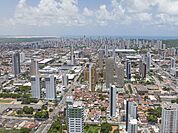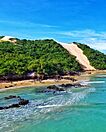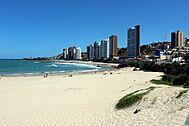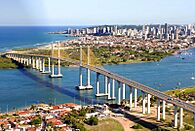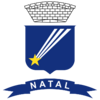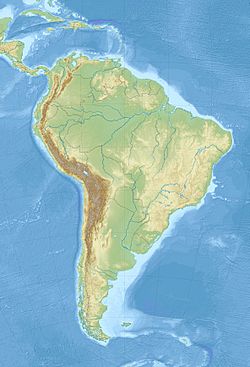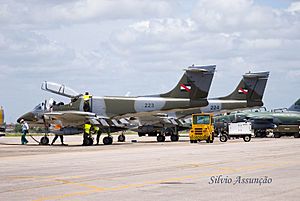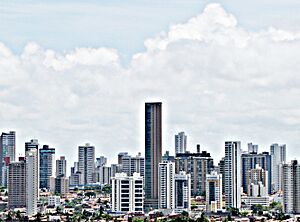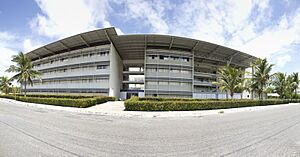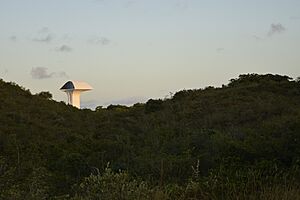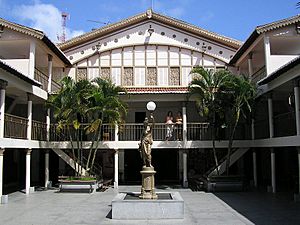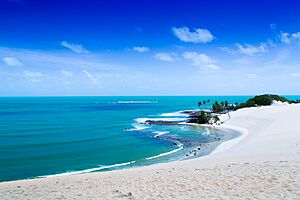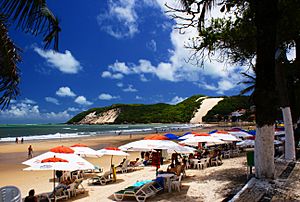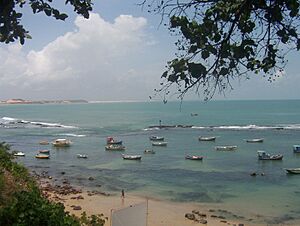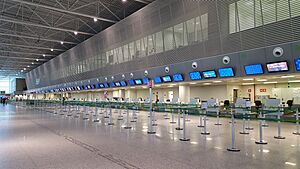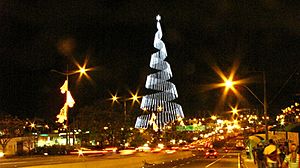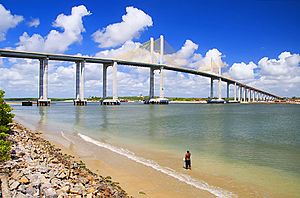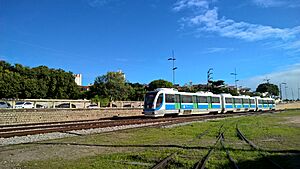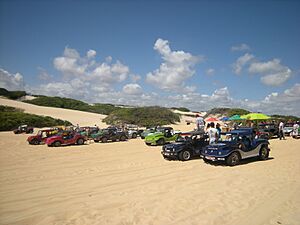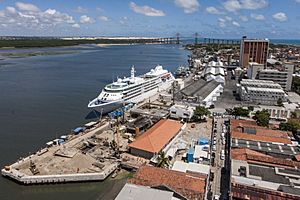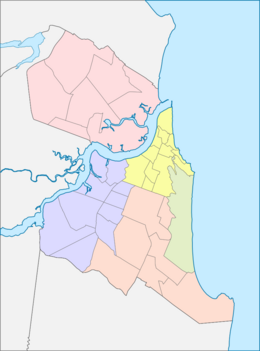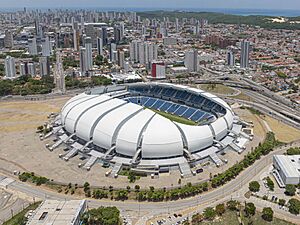Natal, Rio Grande do Norte facts for kids
Quick facts for kids
Natal
|
|||
|---|---|---|---|
|
Municipality
|
|||
| Municipality of Natal | |||
|
From the top, clockwise: Skyline of the city; Morro do Careca in Ponta Negra beach; Praia dos Artistas beach; Natal City Park Tower; Newton Navarro Bridge and Alberto Maranhão Theatre.
|
|||
|
|||
| Nickname(s):
"A Noiva do Sol" ("The Sun's Bride"), "Cidade do Sol" ("The City of the Sun") and "Cidade das Dunas" ("The City of Dunes")
|
|||
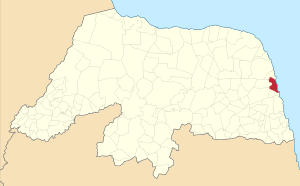 |
|||
| Country | |||
| Region | Northeast | ||
| State | |||
| Founded | December 25, 1599 | ||
| Area | |||
| • Municipality | 167.3 km2 (65.35 sq mi) | ||
| Elevation | 30 m (100 ft) | ||
| Population
(2022)
|
|||
| • Municipality | 751,300 | ||
| • Density | 4,490.7/km2 (11,496.6/sq mi) | ||
| • Metro | 1,520,000 | ||
| Time zone | UTC-3 | ||
| Postal code |
59000-001 to 59139-999
|
||
| Area code | +55 84 | ||
| HDI (2010) | 0.763 – high | ||
Natal is a big city in Brazil. It is the capital of the Rio Grande do Norte state. The name "Natal" means "Christmas" in Portuguese. This is because the city was founded on Christmas Day!
Natal is in northeastern Brazil, right by the Atlantic Ocean. It's known for its beautiful beaches and sunny weather. Many tourists from Brazil and other countries visit Natal every year.
The city is also important for trade. It exports things like crustaceans (like shrimp), carnauba wax, and fruits. Some of the fruits exported are melons, sugar apples, cashews, and papayas.
Natal is special because it's the closest Brazilian city to Africa and Europe. Its airport, Greater Natal International Airport, has flights to many places. In 2014, Natal was one of the cities that hosted the 2014 FIFA World Cup.
Contents
- History of Natal: From Indigenous Peoples to a Modern City
- Geography and Climate: The City of Sun and Dunes
- Population and People of Natal
- Economy: Tourism and Trade in Natal
- Education: Learning in Natal
- Main Sights: Exploring Natal's Attractions
- Natal Dunes State Park
- Museums in Natal
- Natal Aquarium
- Forte dos Reis Magos: A Historic Fortress
- Natal City Park
- Festa Junina: A Lively Festival
- Newton Navarro Bridge
- Historic Center
- Barreira do Inferno Launch Center
- Parrachos de Maracajaú: Natural Pools
- Genipabu: Dunes and Dromedaries
- Ponta Negra and Via Costeira
- Pipa Beach
- Other Fun Attractions
- Culture: Celebrations and Arts
- Transportation: Getting Around Natal
- Neighborhoods of Natal
- Sports in Natal
- Notable People from Natal
- Twin Towns: Natal's Sister Cities
- Images for kids
- See also
History of Natal: From Indigenous Peoples to a Modern City
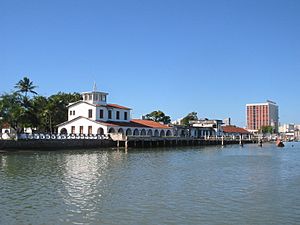
Brazil's coast has been home to native groups for a very long time. The Tupi people lived here, moving from the Amazon about 2,900 years ago.
The Potiguara people were a large group living near what is now Natal. Before Europeans arrived in 1500, over a million native people lived along the Brazilian coast. This was almost as many people as lived in Portugal at that time!
Early European Visits and French Pirates
European sailors first explored this part of South America in 1501. This was part of a Portuguese trip led by Amerigo Vespucci. He named the area Cape São Roque. For many years, no permanent European settlements were built here.
Later, French pirates, led by Jacques Riffault, started trading with the native people. In 1597, the Portuguese Governor-General of Brazil, Francisco de Sousa, ordered them to leave. A successful mission led by Manuel de Mascarenhas Homem and Jerônimo de Albuquerque Maranhão drove out the French.
Founding the City and the Fort
On January 6, 1598, Albuquerque Maranhão began building a fort. It was named "Forte dos Santos Reis" or "Forte dos Reis Magos" (Fort of the Holy Kings or Three Wise Men). This name honored the Three Wise Men, celebrated on that day.
Natal was officially founded on December 25, 1599. This is why the city has its name, which means "Nativity" or "Christmas."
Dutch Occupation and Economic Changes
From 1633 to 1654, Dutch forces took over the fort and the city. They renamed the fort "Fort Ceulen."
Natal's sandy soil meant it couldn't grow much sugarcane. For centuries, the state's economy relied on raising cattle in the dry inland areas. A traditional food from Natal, "carne de sol" (sun meat), comes from this history.
In more recent times, Natal's economy grew thanks to the salt and oil industries. The northern part of Rio Grande do Norte is Brazil's largest salt producer. The state also has large oil reserves.
Natal grew quickly and became a major tourist spot in Brazil.
Natal's Role in World War II
Natal's location is very strategic. It is one of the closest cities in Brazil to Western Europe and Africa. Because of this, an American air base was built in a nearby area called Parnamirim during World War II. This base helped support Allied troops fighting in North Africa.
Thousands of American soldiers came to Natal. Their presence left a mark on the city's culture. Natal also hosted the Potenji Conference. This meeting, held after the Casablanca Conference, decided that Brazil would send troops to fight in Europe. Brazil was the only Latin American country to do so.
Geography and Climate: The City of Sun and Dunes
Natal is located in the far east of South America. It covers about 170 square kilometers (65 square miles). The city sits on the Atlantic Ocean, where the Potengi River meets the sea.
Natal's Tropical Climate
Natal has a tropical climate. This means it's warm to hot and humid all year round. However, ocean winds help keep the temperatures from getting too extreme.
- February is the warmest month.
- July is the coolest month.
- It rains a lot, about 1690 mm (67 inches) per year.
- There's a drier season from September to January.
- Most rain falls between March and July.
Natal is known as the "City of the Sun" and "The City of the Dunes." The sun shines for over 3,000 hours each year. The average temperature is about 27°C (81°F). In summer, it often goes above 30°C (86°F), and the ocean water is around 26°C (79°F).
| Climate data for Natal, Rio Grande do Norte (1991–2020 normals, extremes 1931–1970 and 1983–present) | |||||||||||||
|---|---|---|---|---|---|---|---|---|---|---|---|---|---|
| Month | Jan | Feb | Mar | Apr | May | Jun | Jul | Aug | Sep | Oct | Nov | Dec | Year |
| Record high °C (°F) | 33.4 (92.1) |
36.8 (98.2) |
33.8 (92.8) |
33.0 (91.4) |
32.4 (90.3) |
32.2 (90.0) |
30.8 (87.4) |
31.2 (88.2) |
31.8 (89.2) |
32.5 (90.5) |
32.7 (90.9) |
32.4 (90.3) |
36.8 (98.2) |
| Mean daily maximum °C (°F) | 30.4 (86.7) |
30.7 (87.3) |
30.7 (87.3) |
30.3 (86.5) |
29.8 (85.6) |
28.8 (83.8) |
28.4 (83.1) |
28.6 (83.5) |
29.0 (84.2) |
29.7 (85.5) |
30.0 (86.0) |
30.4 (86.7) |
29.7 (85.5) |
| Daily mean °C (°F) | 27.4 (81.3) |
27.6 (81.7) |
27.5 (81.5) |
27.2 (81.0) |
26.6 (79.9) |
25.4 (77.7) |
24.8 (76.6) |
25.0 (77.0) |
25.8 (78.4) |
26.5 (79.7) |
27.0 (80.6) |
27.4 (81.3) |
26.5 (79.7) |
| Mean daily minimum °C (°F) | 24.4 (75.9) |
24.6 (76.3) |
24.2 (75.6) |
23.7 (74.7) |
23.1 (73.6) |
21.9 (71.4) |
21.0 (69.8) |
21.2 (70.2) |
22.2 (72.0) |
23.5 (74.3) |
24.2 (75.6) |
24.7 (76.5) |
23.2 (73.8) |
| Record low °C (°F) | 18.4 (65.1) |
19.0 (66.2) |
17.9 (64.2) |
17.7 (63.9) |
17.9 (64.2) |
14.8 (58.6) |
16.1 (61.0) |
15.4 (59.7) |
16.6 (61.9) |
17.3 (63.1) |
17.9 (64.2) |
18.4 (65.1) |
14.8 (58.6) |
| Average rainfall mm (inches) | 80.7 (3.18) |
99.8 (3.93) |
200.8 (7.91) |
240.5 (9.47) |
221.8 (8.73) |
348.8 (13.73) |
254.0 (10.00) |
118.7 (4.67) |
54.0 (2.13) |
20.6 (0.81) |
22.5 (0.89) |
29.0 (1.14) |
1,691.2 (66.58) |
| Average rainy days (≥ 1 mm) | 7 | 8 | 13 | 16 | 15 | 18 | 16 | 12 | 8 | 5 | 4 | 5 | 127 |
| Average relative humidity (%) | 79.1 | 79.2 | 80.6 | 82.4 | 82.8 | 84.5 | 82.9 | 80.7 | 79.6 | 77.8 | 77.8 | 78.3 | 80.5 |
| Mean monthly sunshine hours | 256.2 | 228.4 | 241.0 | 218.0 | 232.6 | 199.3 | 215.6 | 253.9 | 267.2 | 295.2 | 285.9 | 286.5 | 2,979.8 |
| Source: Instituto Nacional de Meteorologia | |||||||||||||
Population and People of Natal
| Population growth in Natal | ||||||||||||||||||||||||||||||||||||||||||||||
|---|---|---|---|---|---|---|---|---|---|---|---|---|---|---|---|---|---|---|---|---|---|---|---|---|---|---|---|---|---|---|---|---|---|---|---|---|---|---|---|---|---|---|---|---|---|---|
|
|
|||||||||||||||||||||||||||||||||||||||||||||
In 2022, Natal had about 751,300 people living in the city. The larger metropolitan area, called Greater Natal, had about 1.52 million people.
Natal is one of the smaller state capitals in Brazil by land size. This means it has a high population density, with many people living in a smaller area. It is the 21st largest city in Brazil.
The people of Natal come from many different backgrounds. In 2022, about 46.6% were Pardo (mixed race), 43.2% were White, and 9.8% were Black. There were also smaller groups of Asian and Amerindian people.
Economy: Tourism and Trade in Natal
Natal's most important industry is tourism. It has many beautiful sandy beaches, like Ponta Negra with its famous Morro do Careca dune. Other popular beaches include Tabatinga, Pirangi do Norte, Redinha, Pipa, and Genipabu. Genipabu is famous for its sand dunes and even has dromedaries (camels) for rides!
Many tourists from Brazil, Europe, and the United States visit Natal. The number of foreign tourists visiting Natal grew a lot between 2002 and 2007. This shows how popular Natal is becoming. Natal also gets a lot of international money invested in its coastline.
Natal is also an important center for the oil industry. The state of Rio Grande do Norte is the second-largest oil producer in Brazil. The Federal University of Rio Grande do Norte (UFRN) is a leading center for studying oil sciences.
The fishing industry is also strong in Natal. They export things like shark cartilage to Japan. Growing tropical fruits is another important part of the economy. This includes mangos, guavas, and cashews (both the fruit and the nuts).
The World's Largest Cashew Tree
Near the city center, in Pirangi, you can find the largest cashew tree in the world. In 1994, it was listed in the Guinness book of records. This amazing tree covers an area of 8,400 square meters (about 90,417 square feet). That's bigger than a football field!
This tree has a special genetic change. Its branches grow outwards instead of upwards. When a branch touches the ground, it doesn't create new roots. Instead, a new part of the tree starts to grow from that spot. There's even a special viewing platform inside the tree for visitors.
Education: Learning in Natal
In Brazil, Portuguese is the main language taught in schools. However, students in high school also learn English and Spanish.
Natal has many universities and colleges. Some of the main ones include:
- Federal University of Rio Grande do Norte (UFRN)
- International Institute of Physics (IIP-UFRN)
- International Institute for Neuroscience of Natal (IINN-ELS)
- Universidade do Estado do Rio Grande do Norte (UERN)
- Universidade Potiguar (UnP)
- Instituto Federal do Rio Grande do Norte (IFRN)
There are more than 14 universities across the entire state of Rio Grande do Norte.
Main Sights: Exploring Natal's Attractions
Natal has many interesting places to visit, from natural parks to historic sites and unique attractions.
Natal Dunes State Park
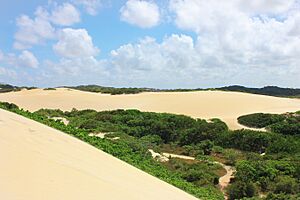
The Natal Dunes State Park is the second largest urban park in Brazil. It covers 1,172 hectares (about 2,896 acres) of land. Here, you can see many plants and animals typical of the Atlantic Forest. You can explore the park along a trail with trained guides. The park also has a jogging track and is open most days.
Museums in Natal
If you like history and art, Natal has several museums:
- Museu de Arte Sacra (Sacred Art Museum)
- Museu de Cultura Popular (Popular Culture Museum)
- Espaço Cultural Palácio Potengi (Potengi Palace Cultural Space)
- Instituto Histórico e Geográfico do Rio Grande do Norte (Historic and Geographic Institute)
- Pinacoteca do Rio Grande do Norte (Art Gallery)
- Museum Camara Cascudo
- Memorial Camara Cascudo
Natal Aquarium
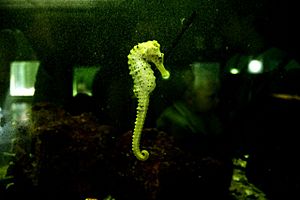
The Natal Aquarium is run by a family of biologists. Besides showing marine animals, it also helps with surgeries for sea creatures. The aquarium has about 60 different marine species. These include various fish (even piranhas!), sea horses, shrimps, lobsters, stingrays, and octopus. There's even a special cool tank with penguins!
Forte dos Reis Magos: A Historic Fortress
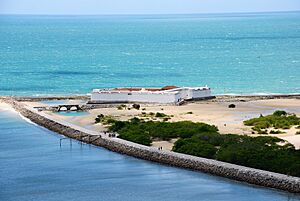
The Forte dos Reis Magos (Fortress of the Three Wise Men) is a historic fortress. It was the first building in the city, started on January 6, 1598. This date is the Christian holiday of Epiphany, honoring the Three Wise Men. The fort is now a museum.
Natal City Park
The Natal City Park Dom Nivaldo Monte, or simply the City Park, opened in 2008. It was designed by the famous architect Oscar Niemeyer. It features a unique, tall tower, a museum, and a restaurant.
Festa Junina: A Lively Festival
Festa Junina (Saint John Festival) is a very popular celebration in northeastern Brazil. It was brought by the Portuguese. Unlike in Europe, where it's a summer festival, in Brazil, it happens during the tropical winter.
The festivities start after June 12th and last until June 29th. During this time, you'll see bonfires, fireworks, and folk dancing in the streets. People wear peasant costumes, dance, and enjoy special foods and drinks. Bonfires are a big part of these celebrations.
The Newton Navarro bridge is one of the tallest bridges in Brazil. It offers amazing sunset views over the Potengi River. This bridge connects Natal to the northern coast beaches. It helps with city traffic and has become a popular tourist spot because of its impressive size.
Historic Center
Natal's Historic Center covers a large area with about 150 buildings. These buildings show different styles, like colonial, neoclassical, art-deco, and modernist. This area includes the oldest neighborhoods of the city, Ribeira and Cidade Alta. They show important parts of Brazil's early history and Portuguese colonization.
Barreira do Inferno Launch Center
The Barreira do Inferno Launch Center was Brazil's first rocket launch base. Today, it launches small and medium rockets. You can visit it to see the rockets, but you need to make an appointment.
Parrachos de Maracajaú: Natural Pools
The Parrachos de Maracajaú are coral reefs about 7 kilometers (4.3 miles) off Maracajaú beach. They form natural pools, perfect for snorkeling and diving. When the tide is low, you can even touch the surface of the corals. The water here is very clear, making it great for underwater exploration. Maracajaú beach is about 60 kilometers (37 miles) from Natal. There's also a water park called Ma-Noa Park nearby.
Genipabu: Dunes and Dromedaries
Genipabu (or Jenipabu) is a famous area near Natal with huge sand dunes, a lagoon, and a protected environment. It's a big tourist attraction. You can enjoy "buggy" rides over the dunes. You can also try "esquibunda," where people slide down the dunes on wooden boards into the lagoon. For a unique experience, you can even ride dromedaries (camels) here!
Ponta Negra and Via Costeira
Ponta Negra is a very famous beach and neighborhood in Natal. At the southern end of the beach is Morro do Careca (Bald Hill), a large dune. To the north is the Via Costeira (Coastal Way), a road that runs through coastal dunes and connects many city beaches.
Ponta Negra beach is fully developed with many shops, restaurants, bars, and nightclubs. The sand is lined with "tents" or huts that serve food and drinks. You'll often see "jangadas," which are colorful, simple fishing boats typical of northeastern Brazil. The Via Costeira is a large avenue built along the city's dunes and beaches.
Pipa Beach
Pipa Beach is about 85 kilometers (53 miles) from Natal. It's a beautiful, peaceful beach away from city centers. It attracts thousands of tourists every year.
Other Fun Attractions
- Since Natal means Christmas, December often has special events. These include concerts, plays, and the traditional lighting of fires. The city is also decorated for Christmas.
- Cape São Roque is the point on the Brazilian coast closest to Africa.
- Calcanhar Lighthouse is the tallest lighthouse in Brazil.
Culture: Celebrations and Arts
Carnatal: Off-Season Carnival
Carnival in Natal is called "Carnatal." It's one of Brazil's biggest off-season carnivals. Carnatal usually happens in November or December around the Arena das Dunas Stadium. Streets are closed off to create a party area.
During the festival, a huge truck called a "trio elétrico" drives slowly through the streets. It has a band on top and big speakers. Crowds follow the truck, singing, dancing, and jumping to the music.
Natal also hosts other festivals, like "Mada," a national pop rock festival, and "Verão de Todos," a summer festival.
The city's patron saint is Our Lady of Presentation.
Transportation: Getting Around Natal
Natal has various ways to get around, from air travel to local buses and unique dune buggies.
International Airport
The Greater Natal International Airport is located about 30 kilometers (19 miles) from Natal. It's at sea level and has good weather conditions. This makes it an important airport for the region.
Air Force Base
Natal Air Force Base - ALA10 is one of the most important bases for the Brazilian Air Force. It's located in the nearby city of Parnamirim.
Highways and Roads
The main highway to Natal from the south of Brazil is Federal Highway BR-101. If you're coming from the state of Ceará, you'll use Federal Highway BR-304.
Leaving Natal, the "Sun Route" (Rota do Sol), also known as RN-063, takes you to southern beaches like Pirangi and Búzios. The North Shore is reached via the Newton Navarro bridge.
Bus Travel
Buses are the cheapest way to travel within Natal. You can buy passes or magnetic cards, or just pay the conductor. There are large buses, micro buses, and vans, all charging the same fares.
Most major tourist spots in Natal are served by buses. You might have to stand on the larger buses. Waiting times are usually around 15 minutes during busy hours.
Natal also has a main Bus Terminal that connects the city to all 167 municipalities in Rio Grande do Norte. You can also take buses from here to other major Brazilian cities like Belo Horizonte, Fortaleza, and Recife.
Rail System
The Sistema de Trens Urbanos de Natal is a two-line commuter rail system. It covers over 56 kilometers (35 miles) of track. In 2018, it served 3.7 million passengers.
Taxis
Taxis are easy to find in Natal. They are white cars with red license plates. Fares are set by the government. There's a starting fee, a cost per kilometer, and a waiting fee. From 10 PM to 6 AM on weekdays, and all day on weekends, prices increase by 20%.
Dune Buggies
The dune buggy is a popular vehicle for exploring the beaches. Some companies offer tours in 4WD vehicles, but buggies offer a unique experience. Riding a buggy lets you feel the sun and wind. Most dune buggy drivers are certified for safety.
Port of Natal
The Port of Natal specializes in carrying goods that need to be kept cold, like fruit, fish, and shrimp. It has its own customs facilities. The port is directly connected to European ports like Vigo, Rotterdam, and Sheerness.
Neighborhoods of Natal
Natal is divided into different zones, each with its own neighborhoods:
|
North Zone
|
East Zone
|
West Zone
|
South Zone
|
Sports in Natal
Natal is home to several soccer teams:
- ABC Futebol Clube
- Alecrim Futebol Clube
- América de Natal
Stadiums and Gymnasiums
The city has important sports venues:
- Arena das Dunas (a major stadium)
- Maria Lamas Farache Stadium (Frasqueirão)
- Juvenal Lamartine Stadium
- Ginásio Nélio Dias (a gymnasium)
- Palácio dos Esportes (Palace of Sports)
Natal as a Host City for Major Events
Natal was one of the host cities for the 2014 FIFA World Cup. The Dunas Arena was built for this event. A new airport, Greater Natal International Airport, was also built. The city also invested in public transport, including a light rail system called VLT de Natal.
David Beckham had plans to open a football academy in Natal, called the Beckham World of Sport, to go along with the 2014 FIFA World Cup.
Natal was also the first Brazilian city to host a World Maxibasketball Championship. The 11th World Maxibasketball Championship took place in July 2011. It brought about 3,500 athletes from around the world to the city.
Notable People from Natal
People who live in Natal are called Natalenses. Many famous people come from Natal:

- Abraham Palatnik, artist and inventor
- Aldo Parisot, cellist and cello teacher
- Café Filho, a lawyer and former president of Brazil (1954–1955)
- Carlos Paz de Araújo, scientist and inventor
- Clodoaldo Silva, paralympic swimmer
- Fernanda Tavares, international model
- Garibaldi Alves Filho, politician
- Jussier da Silva, mixed martial artist
- Larissa Costa, model and Miss Brasil 2009
- Luís da Câmara Cascudo, anthropologist, folklorist, and historian
- Marinho Chagas, football player
- Oscar Schmidt, basketball player
- Patrício Freire, mixed martial artist champion
- Patricky Freire, mixed martial artist
- Renan Barão, mixed martial artist
- Roberta Sá, singer
- Virna Dias, volleyball player
Twin Towns: Natal's Sister Cities
Natal has "twin towns" or "sister cities" around the world. These are cities that have special friendly relationships.
 Bethlehem, Palestine
Bethlehem, Palestine Córdoba, Argentina
Córdoba, Argentina
 Porto Alegre, Rio Grande do Sul, Brazil
Porto Alegre, Rio Grande do Sul, Brazil
 Rio de Janeiro, Rio de Janeiro, Brazil
Rio de Janeiro, Rio de Janeiro, Brazil
 Salvador, Bahia, Brazil
Salvador, Bahia, Brazil
 Fortaleza, Ceará, Brazil
Fortaleza, Ceará, Brazil Eilat, Israel
Eilat, Israel
Images for kids
See also
 In Spanish: Natal (Brasil) para niños
In Spanish: Natal (Brasil) para niños


